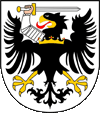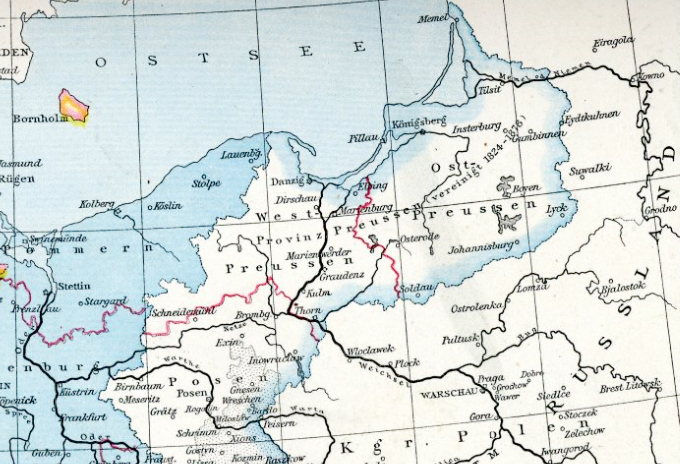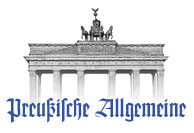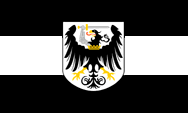
From 1875, the provinces of Prussia could largely operate in self-governing. There was a provincial parliament and a provincial government (Provincial Committee). Each province had its own colors (Landesfarben), which were also used as flag, and they had also their own coat of arms. If the provincial governments put for official purposes (official flag) their coats of arms on a flag with the provincial colors is not handed down beyond doubt and not for all provinces. The flag of the province Westprussia shows three stripes in black, whita and black, and is so a combination of the prussian colours black and white. Especially characteristic is the in the coat of arms depicted eagle. He has besides wings even a sword arm. (look → Coat of arms)
Source: Volker Preuß


to 1920,
Coat of arms of the Province of West Prussia,
Source, by: Deutsche Wappen Rolle

The origins of the Prussian heraldry can be found in Royal Polish Prussia when these areas (Pomerelia [later West Prussia], Kulm Land, Marienburg and Elbing) were ceded to the Kingdom of Poland in 1466 and became a fief of the Polish king. A coat of arms was created for this country. It showed the Polish eagle in black on a silver (white) background with a sword arm. The colors were probably not chosen at random, after all, the Royal Polish Prussia was previously a territory of the Teutonic Order, the colors of the order were black and white (black cross on a white background). In 1525, Grand Master Albrecht converted the remaining State of the Teutonic Order (in principle the area of what would later become East Prussia, but without the Diocese of Warmia) into the secular Duchy of Prussia, Albrecht became the duke and swore the oath of fief to the Polish king. Another coat of arms was created for this, again according to the same principles. It showed the Polish eagle in black on a silver (white) background and it had a crowned breastplate with the initial "S" of the Polish king Sigismund. The coat of arms of Prussia was thus created. Later, when Prussia was divided into provinces, this original Prussian coat of arms became the coat of arms of the province of East Prussia, but without the breastplate with the "S", which had already become obsolete in 1557 when the Polish feudal sovereignty ceased to exist. On the occasion of the Polish divisions, Prussia was able to gain Royal Polish Prussia in 1772. Its coat of arms (the eagle with the sword arm) was adopted for the later province of West Prussia.
Source:
Volker Preuß,
Deutsche Wappen Rolle,
www.heraldique.org


Source: Professor G. Droysens Allgemeiner Historischer Handatlas, 1886
The historical map shows in the middle the Province of West Prussia between the years 1815 and 1866.

Area: 9.867 square miles
Inhabitants: 1.703.500 (1910)
Density of Population: 172 inh./sq.mi.
Capital: Danzig
Source: Wikipedia (D)

since 1226/1309 · to the State of the Teutonic Order (teutonic knights)
1466 · to Poland
1772 · to Prussia
1824 · unification with East Prussia to the Province of Prussia
1878 · creation of the Province of West Prussia
1920 · in result of the Versailles dictate dissolution and partition of West Prussia:
1. Pomerellen (to Poland)
2. Danzig (free town)
3. governmental district West Prussia (to the Province of East Prussia)
4. districts of Deutsch-Krone, Flatow and Schlochau (to the Border-Province of Posen - West Prussia)
Source: Atlas zur Geschichte,
Wikipedia (D),
Discovery '97,
Schwarzbuch der Vertreibung

The name of the country goes back to the Baltic people of the Old Prussians (in German called Pruzzen), who lived in the 13th century in the area of today's East Prussia, and were subjugated and christianized by the Teutonic Order on behalf of the King of Poland. The Elector of Brandenburg from the House of Hohenzollern also held the title of Duke in Prussia from 1618, and from 1701 he called himself King in Prussia. As a result, from this time on, all Hohenzollern territories were combined under the name of the Kingdom of Prussia.
Source: Wikipedia (D)







Preußische Allgemeine Zeitung
Die Fundgrube für Geschichtsbegeisterte. Mit sehr großem kostenlosen Archiv mit den kompletten Ausgaben dieser Zeitung mit sehr interessanten Artikeln über die preußische Geschichte.

![]()










